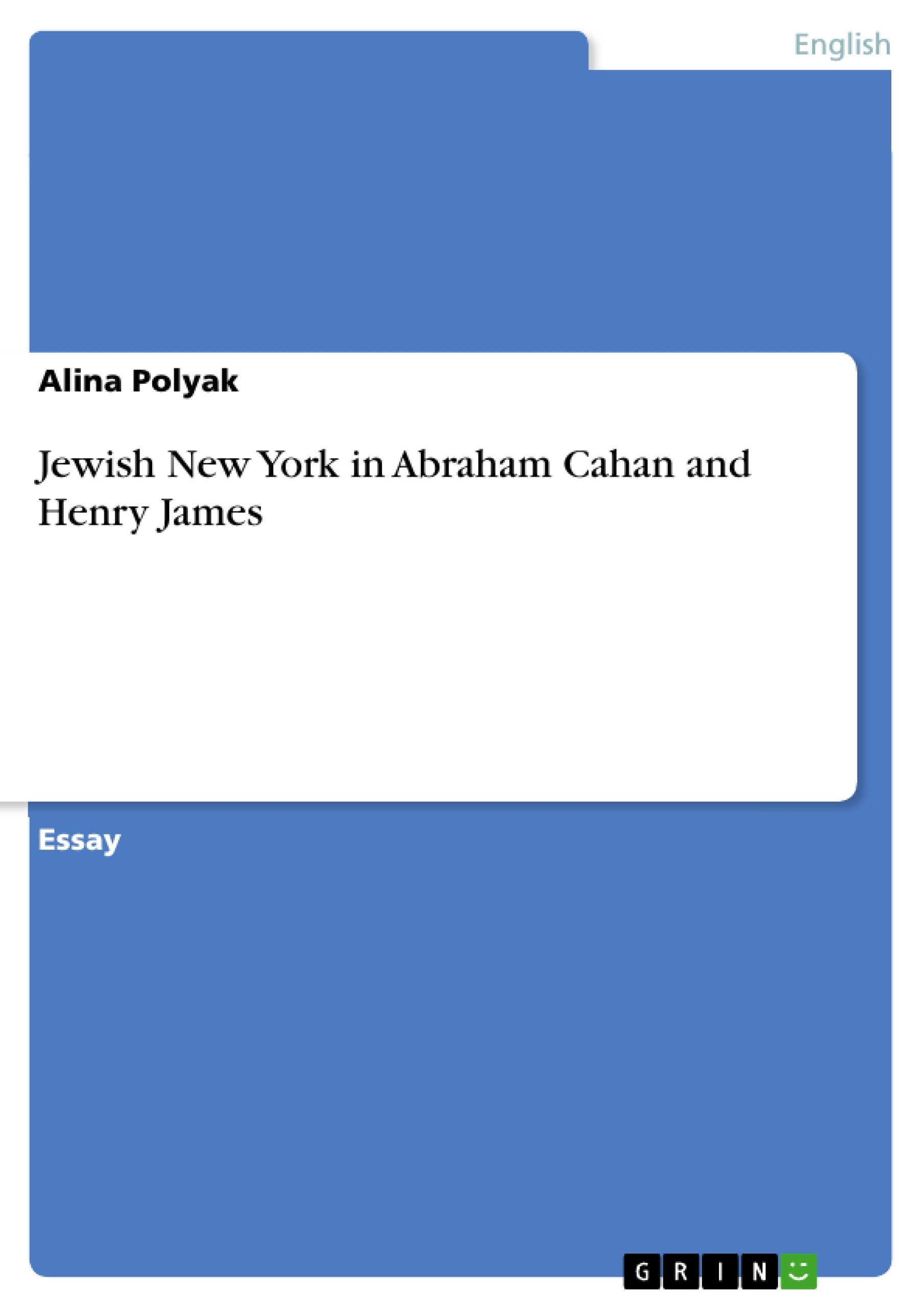I have decided to write my paper about Jewish New York and in particular the Lower East Side because it is a very important place in the history of Jewish America. This is a place which is inseparable from general American history, because it was influenced and shaped by immigrant culture. Jewish and American cultures merged and influenced each other on different levels.
The Jews in America had more freedom than anywhere else in the world,
Anti-Semitism was milder and could not be compared to its Eastern European form. The English language was influenced by Yiddish, and Yiddish absorbed English words and expressions.
New York became the gateway for immigrants at the end of the nineteenth century.
Inhaltsverzeichnis (Table of Contents)
- Jewish New York in Abraham Cahan's “The Rise of David Levinsky” and Henry James' “The American Scene”
Zielsetzung und Themenschwerpunkte (Objectives and Key Themes)
The objective of this paper is to analyze the portrayal of Jewish New York, specifically the Lower East Side, in Abraham Cahan's "The Rise of David Levinsky" and Henry James' "The American Scene." It examines how these authors, representing insider and outsider perspectives respectively, depict the immigrant experience and the transformation of the Lower East Side.
- The Lower East Side as a symbol of Jewish immigrant experience in America.
- Contrasting perspectives of the Lower East Side: insider vs. outsider.
- The process of assimilation and Americanization among Jewish immigrants.
- The economic and social conditions of the Lower East Side.
- The role of language and culture in shaping identity.
Zusammenfassung der Kapitel (Chapter Summaries)
Jewish New York in Abraham Cahan's “The Rise of David Levinsky” and Henry James' “The American Scene”: This paper explores the representation of Jewish New York, particularly the Lower East Side, through the contrasting lenses of Abraham Cahan's "The Rise of David Levinsky" and Henry James' "The American Scene." Cahan, an insider, portrays the Lower East Side as a vibrant hub of Jewish life, highlighting both its hardships and its potential for upward mobility. James, an outsider, offers a more critical and often dehumanizing depiction, focusing on the perceived squalor and overwhelming presence of the immigrant population. The analysis compares and contrasts these perspectives, examining how the authors' viewpoints shape their representations of the immigrant experience, the transformation of the Lower East Side, and the complex relationship between Jewish culture and American society. The study delves into themes of assimilation, economic struggle, and the role of language in shaping identity within the context of the Lower East Side's historical significance.
Schlüsselwörter (Keywords)
Jewish New York, Lower East Side, immigration, assimilation, Americanization, Abraham Cahan, Henry James, "The Rise of David Levinsky," "The American Scene," immigrant experience, cultural identity, economic hardship, insider perspective, outsider perspective.
Frequently Asked Questions: Jewish New York in Abraham Cahan's “The Rise of David Levinsky” and Henry James' “The American Scene”
What is the main focus of this academic paper?
This paper analyzes the portrayal of Jewish New York, specifically the Lower East Side, in Abraham Cahan's "The Rise of David Levinsky" and Henry James' "The American Scene." It compares and contrasts the perspectives of an insider (Cahan) and an outsider (James) on the immigrant experience and the transformation of the Lower East Side.
What are the key themes explored in the paper?
The paper explores several key themes, including the Lower East Side as a symbol of the Jewish immigrant experience, contrasting insider and outsider perspectives, the processes of assimilation and Americanization, economic and social conditions on the Lower East Side, and the role of language and culture in shaping identity.
What are the contrasting perspectives of Cahan and James?
Cahan, an insider with firsthand experience, portrays the Lower East Side as a vibrant hub of Jewish life with both hardships and opportunities for upward mobility. James, an outsider, offers a more critical and sometimes dehumanizing view, focusing on perceived squalor and the sheer number of immigrants. The paper examines how these different perspectives shape their depictions of the immigrant experience and the Lower East Side's transformation.
What are some of the specific topics discussed within the paper's analysis?
The analysis delves into themes of assimilation, economic struggles faced by immigrants, and how language played a crucial role in shaping identity within the historical context of the Lower East Side. The contrasting viewpoints of Cahan and James provide a rich source of analysis for understanding the complexities of the immigrant experience in early 20th-century New York.
What are the key objectives of this academic work?
The main objective is to analyze how Abraham Cahan and Henry James, representing insider and outsider perspectives respectively, depicted Jewish life on the Lower East Side and the immigrant experience. The paper aims to illuminate the complexities of assimilation and the social and economic conditions of the time.
What are the keywords associated with this paper?
Key words include: Jewish New York, Lower East Side, immigration, assimilation, Americanization, Abraham Cahan, Henry James, "The Rise of David Levinsky," "The American Scene," immigrant experience, cultural identity, economic hardship, insider perspective, outsider perspective.
What is included in this preview?
This preview provides a comprehensive overview of the academic paper, including the title, table of contents, objectives and key themes, chapter summaries, and keywords. It offers a detailed outline of the paper's content and methodology.
- Arbeit zitieren
- Alina Polyak (Autor:in), 2006, Jewish New York in Abraham Cahan and Henry James, München, GRIN Verlag, https://www.grin.com/document/55423




